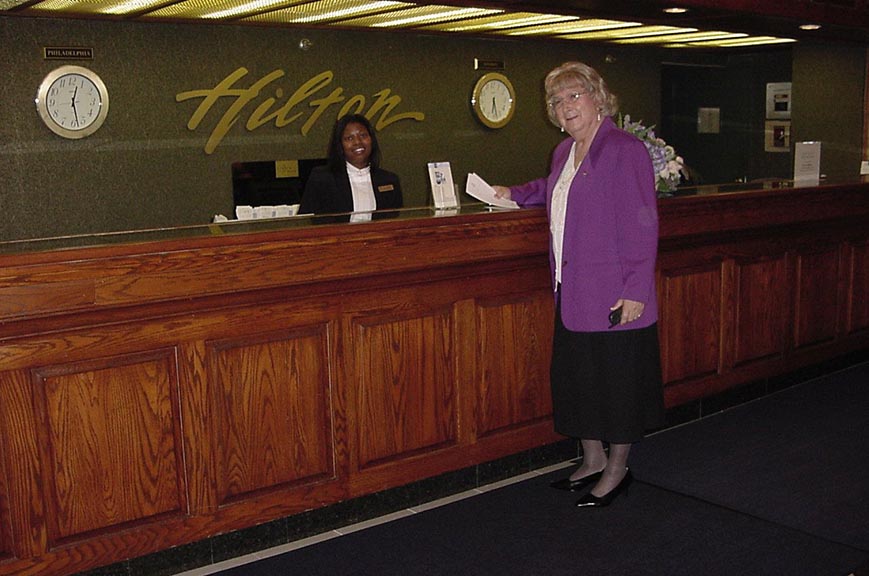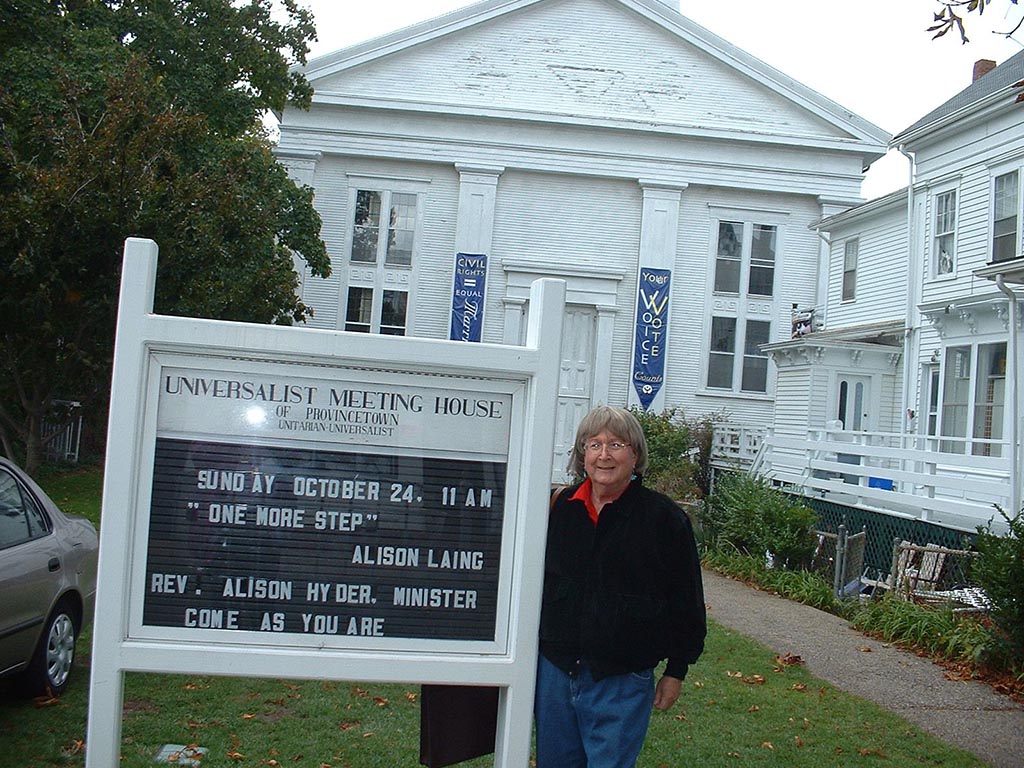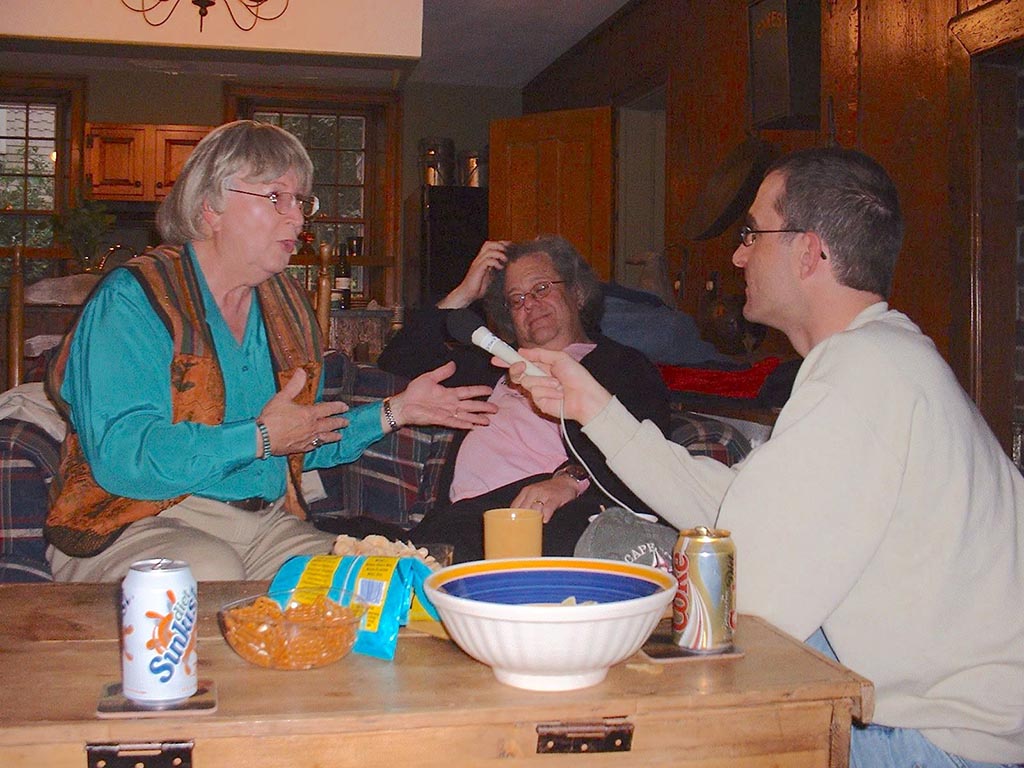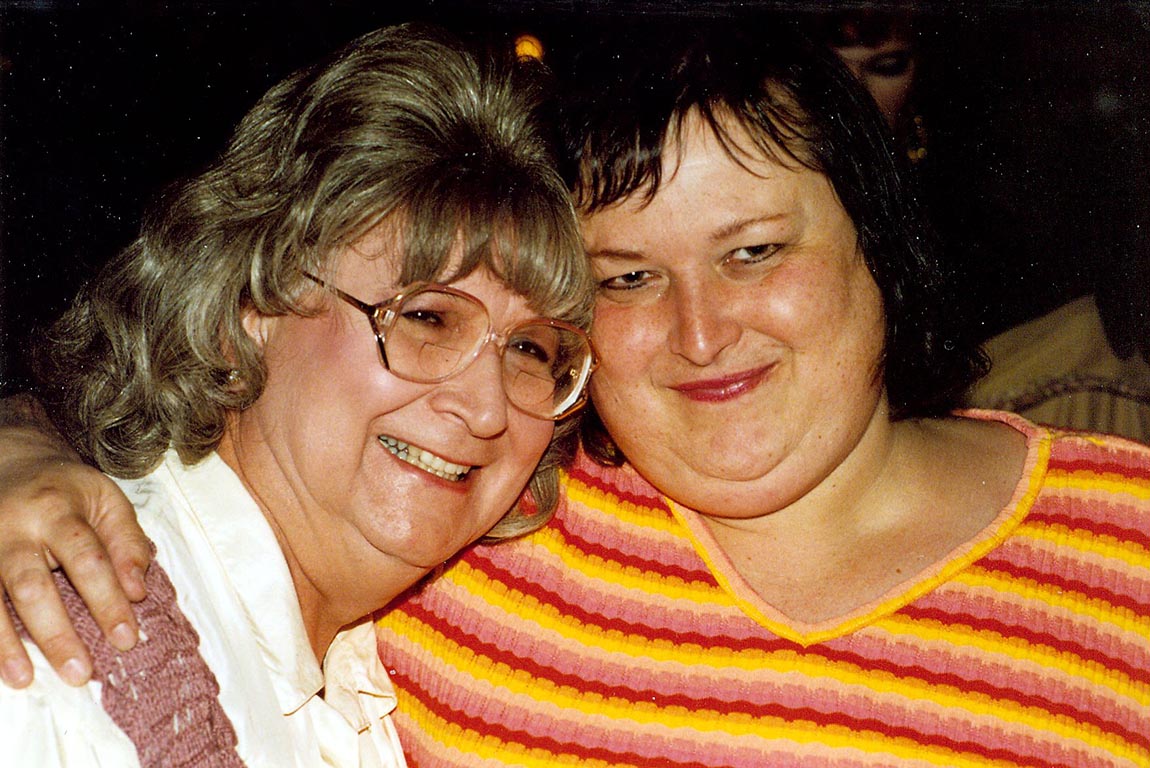Remembering Alison Laing
View photos of Alison and some of her friends and associates over the years before you read Dallas Denny’s remembrance. Click on the first thumbnail and the image will open in a large size. Use the navigation << >> tools in the lower corners of the image to view all the photos. When done click on the last photo to return to this page.
I met the wonderful Alison Laing in San Antonio at the 1991 conference of the International Foundation for Gender Education. I was sitting in a quiet corner of the lobby, playing my guitar and singing. Alison wandered up, listened for a few minutes with a huge smile on her face, and when I paused, she said, “I like you. You and I are going to be friends.”
And indeed we were.
I really got to to know Alison, when, in 1992, she called me and asked me if I would agree to serve on the board of the Outreach Institute, the nonprofit that ran Fantasia Fair. I had heard stories of financial misappropriation and was skeptical, but I told Alison I would serve, providing we work together to bring order to the organization. We worked alongside one another to that end for years before it finally happened. I learned to admire her and respect her.
Alison was a gentle soul. She saw the good in everyone and everything and carried around that rarest and most precious thing in an adult—a child’s sense of wonder. She embraced both her masculine and feminine sides, and her achievements on both sides were major. As Al, she was an executive for a big electronics company (no, not IBM), and before that, she, and this just delights hell out of me, discovered a previously unknown isotope of aluminum. As Al, she was husband to the wonderful Dottie Laing and father to four great children. As Alison, she was a founder of Renaissance Education Association (TGForum’s Angela Gardner was another founder!). She was a long-time board member and for two years Executive Director of IFGE, and a long-time board member and for a number of years Director of the long-running transgender conference Fantasia Fair (Dottie became Director when Alison stepped down!) Alison was involved with the Congress of Transgender Organizations, GenderPAC, Transgender Alliance for Community, Trans Events, and assorted other transgender organizations.
Alison was a highly spiritual person, and respected the two-spirit traditions of America’s indigenous peoples. Her dress sometimes reflected this admiration. I remember her at the pulpit at the Unitarian Universalist Church in Provincetown, leading worship while wearing a headband and a jacket patterned after a Navajo rug, her shamanic garb.
Alison could appear more than a bit unorganized, but I soon recognized what it actually was. Like me, she had an ability to do a dozen or more things or hold a dozen or more conversations simultaneously. I remember in particular a taxi ride down Provincetown’s Commercial Street some time late in the last century. I was sitting in the passenger seat, and Alison was driving. Miqqi Gilbert and Stephanie Pierce and, I believe, Jamie Dailey, were in the back seat. As we inched down the street in heavy traffic, Alison and I engaged in at least eight conversations, jumping abruptly from one topic to the next. To us, it was just a talk, but when I looked in the rear view mirror and saw mouths hanging open, I realized not everyone shared or appreciated our multitasking abilities.
We both reined in when talking with neurotypical folks, but when it was just the two of us, it was pedal to the metal, often three hours up and down the Cape to and from Provincetown.
I was graced to stay at Alison and Dottie’s homes near King of Prussia, Pennsylvania and their waterside cottage in Rhode Island. Both houses were chock full of bric-a-brac, which mirrors my own style. There were papers from Al’s workplace, a basement with a world-class collections of wines, and an equally impressive collection of pottery. I remember being entirely impressed when Alison and JoAnn Roberts gave me a tour of Valley Forge National Historic Park and I saw pieces of pottery by Al and Dottie on display; they had created pieces representative of the area during the Revolutionary War period.
Once, when I visited, Alison had a dozen or so pairs of her vintage—very vintage—shoes on a table. She was, she said, planning to sell them or donate them to Goodwill. She picked up a pair of pink stilettos and told me she had been wearing them when, as a young person on one of her first outings en femme, had been chased by a Philadelphia policeman. She had outrun him, too!
I begged her to give them to me or sell them to me. They were, I told her, historical artifacts. “Alison, I donated two pairs of Virginia Prince’s shoes from the 1950s to the Labadie Collection at the University of Michigan, and they were on exhibit there. I’m not kidding.” Alison wouldn’t believe I was serious, couldn’t believe her shoes were worthy. Try as I might, I never got the shoes. More’s the pity.
I remember with fondness Allison and Dottie’s mini-van, always loaded to the roof with clothes, wigs, computer equipment, cables, books, reams of paper, food, and god knows what all else. Alison (not Dottie, it was all Alison!) had crammed in half their household, filling every square inch in preparation for Fantasia Fair. And I remember once picking her up on the way to the Fair. I had hitched rides with a Fair attendee.
When we stopped at Alison’s house to pick her up, she began to lug suitcases and boxes outside. To our amazement, she didn’t stop until there were thirteen—count em!—pieces of luggage sitting there, ready for loading. “Alison,” I said, “do you really need all that?” Of course she did. We managed to get everything in the Ford Ranger, but the three of us had to breath shallowly all the way up the Cape.
When Dottie passed away, Al was left with a house far too large. With the help of his children, the house in Rode Island was sold and Al moved to a retirement facility in Pennsylvania, where he resided until his death. He had a good time there, teaching courses about wine and getting lots of attention from the ladies, but it was not a safe place to crossdress, and Alison was forced into the background. Her only appearances were at Fantasia Fair, and it was a sad day when her health no longer permitted traveling.
Two or three winters ago, Alison’s daughters Betsy and Margie drove to my house in a SUV loaded with Alison’s transgender materials and helped me tote boxes to my basement. There was a lot of great stuff—long runs of Renaissance News, LadyLike, and Transgender Tapestry and other newsletters and magazines. There were books; flyers and brochures and programs from dozens of transgender conferences, dating to the ‘80s; videotapes; personal correspondence and business letters from Alison’s many years of service with Renaissance, Fantasia Fair, and IFGE; paste-ups of newsletters from the days before desktop publishing; t-shirts, engraved wine glasses—everything trans in the world except for the shoes I had so coveted. As a collection, it was a snapshot of the love and complexity that was Alison Laing—and Al.
I spent the winter sorting through and organizing those materials and arranging to donate them to various archives and museums. In the end, I sent the IFGE materials to the Transgender Archive in Victoria, British Columbia and the Fantasia Fair and Renaissance materials to the Labadie Collection in Ann Arbor, Michigan. I parsed the magazines, sending material to Victoria and Ann Arbor and other places that were building trans collections—for instance, the University of Minnesota. I arranged for materials to be routed first to the Digital Transgender Archive, where volunteers scanned them and placed the files online. Much of the material on the DTA site comes from Alison’s collection.
Before the materials were donated, I had a conversation with Betsy, who consulted her siblings. We talked about what was private, and what was for public consumption. Her siblings had some concerns about privacy, but to their credit, the siblings were proud of Alison as well as Al and wanted to honor her. I helped the family develop guidelines to protect Al and Dottie and assured everyone the receiving institutions would respect those guidelines. The materials, I told Betsy, would be available to scholars and trans people.
I had been channeling trans materials to libraries and archives for decades, but I didn’t foresee how everything would change when Alison’s materials were placed online at the DTA. The archivists in Victoria and Ann Arbor and at the DTA followed the family’s guidelines, but none of us could have predicted the way online access would take things to a new level.
It didn’t take long for journalists to seize upon two photo albums that documented Alison’s early crossdressing. Suddenly Buzzfeed and The Smithsonian Institution and The Advocate were publishing articles about Alison’s courage as a young trans woman in the 1950s and 1960s. The family was rightfully concerned by the exposure, and so was I on their behalf, but the journalists were respectful, celebrating Alison’s uniqueness and courage, and that made the family—and me—proud.
I looked today at those photographs. They reflect a time when the trans community was for all practical
purposes nonexistent, and Alison’s photos reflect that. They show her, dressed and alone, sitting on a cannon, at a covered bridge in Vermont, at a harbor, on a mountaintop. No one else is there, save the unseen photographer, almost certainly Dottie. Such was Alison’s courage. She was out there, expressing herself, alone and no doubt frightened, and journalists visiting the DTA had seen it all, and had appreciated it enough to share it with others.
There will be a remembrance of Alison at Fantasia Fair, October 20-27, 2019 in Provincetown. I will be there to remember her, as I am remembering her now.
In lieu of flowers, donations may be made in Alison’s name to Fantasia Fair, which was dear to her heart.
Fantasia Fair
P.O. Box 293
East Bridgewater, MA 02333
References:
Abeni, Cleis. (2016, 21 March). Trans Woman Dared to Be Herself in the 1960s. https://www.advocate.com/transgender/2016/3/21/photos-trans-woman-dared-be-herself-1960s-america (Retrieved 24 January, 2019).
Blakemore, Erin. (2016, 29 March). This transgender archive’s oldest artifacts tell a story of courage and community. Smartnews. https://www.smithsonianmag.com/smart-news/new-transgender-archives-oldest-artifacts-tell-story-courage-community-180958589/ (Retrieved 24 January, 2019).
Photos of Alison Laing. Digital Transgender Archive. https://www.digitaltransgenderarchive.net/col/jw827b72z (Retrieved 24 January, 2019). Courtesy of Joseph A. Labadie Collection, University of Michigan, Ann Arbor.
Moved to make a comment? Login here and use the comment area below.
Category: History, Transgender Body & Soul, Transgender Community News, Transgender History




















